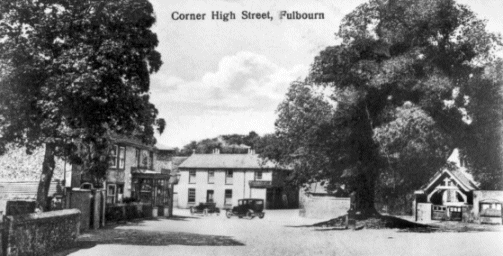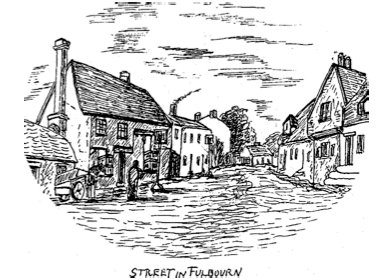Welcome to the Official Website of the Fulbourn Village History Society
Our site has been re-designed just in time for our 25th Anniversary!

Fulbourn is a large village of over 6000, situated on the south eastern edge of Cambridge and surrounded on three sides by agricultural land. The village has a very rich history indeed. Archaeological evidence of habitation in the area has been found dating as far back as the Neolithic period, and there have also been numerous finds from the Roman and Anglo-saxon periods as well. The name has so far been traced back to 991 AD and is thought to derive from the Anglo-saxon “Fugleburn” meaning “stream freqented by waterfowl”.
Upcoming Events
17 October, 2024
‘A History of the Mill’ by Steve Temple
21 November, 2024
‘The History of Chivers’ by David Oates
12 December, 2024
‘The History of Christmas’ by Sean Lang
16 January, 2025
‘How a Cambridge man made the Victorian Post Office so great – and what has gone wrong’ by Prof. Martin Daunton
20 February, 2025
‘A community of negligent, thoughtless, dissolute and incontinent spiritual harlots? The nunnery of St Radegund, Cambridge, and other religious women in medieval Cambridgeshire’ by Craig Cessford
20 March, 2025
‘Seeing Science – Objects from the Whipple Museum’ by Alison Giles
17 April, 2025
‘Fulbourn Windmill’ by Ian Harrison
Talks start at 7.30 pm in the Fulbourn Centre
Talks and events are open to the public. Non-members and guests entry £3.00 per person. Enquiries by email to info@fulbournhistory.org.uk
The Society will undertake research of our archives at a charge of £20 per hour, including free domestic postage. International postage is £1.50. Photo quality printing charges: A5 – £5 A4 – £8
Paypal payments may be sent to: paypal@fulbournhistory.org.uk

Details
Details
Details
Details
A Tale of Two Villages?
At one time, the village had two ecclesiastical parishes with both churches in the same churchyard, separated by a mere seven feet; All Saints, believed to be the earlier, and St. Vigor’s. These were likely established by two different and possibly rival lords. This led to much speculation as to whether there once were two villages. In fact, some early maps even depict “Fulbourn Magna” and “Fulbourn Parva”. However a research project conducted by the Fulbourn Village History Society came to the conclusion that there was only ever one Fulbourn. (The full report of the project entitled “In Search of Fulbourn” is available free to members of the FVHS, or the PDF can be purchased separately.)
A Medieval Moated Manor
The project also investigated another fascinating landmark in Fulbourn; a medieval moated site. The site at Hall Orchard, known as Dunmowes survives as an earthwork and has a water filled moat when suitable conditions exist.
The excavations that were undertaken show that the moated area had been occupied from at least the early 13th century until the late 17th century. The moat platform and ditch were probably constructed in the the late 12th or early 13th century with the soil and chalk dug out from the ditch being piled into the central area to create a raised platform. A large drainage ditch at the southwest corner and one at the northeast corner meet the moat ditch. These were probably inlet and outlet channels supplying the moat with continuous running water.
It is fascinating to speculate upon the relative wealth and importance of Dunmowes Manor, and some clues are available from the archaeological evidence. Decorative features associated with the building which were above and beyond a practical and utilitarian purpose indicate that the owners intended to impress their neighbours and emphasise their own importance.
By the late medieval and early post medieval period, most, if not all, of the buildings at Hall Orchard, rather than being thatched, may have been covered in relatively expensive stone roofing tiles, which were later replaced by clay peg tiles, having glazed and decorated finials and ridge tiles. Many fragments were very small, suggesting demolition of the house with any complete tiles perhaps removed for re-use elsewhere.
Trouble Brewing
In the 14th century, Fulboun had numerous ‘Alewives’, with a reputation for keeping late hours. In 1700, three public houses were recorded. One of them, The Six Bells, still thrives today and is housed in a thatched timber framed building dating from the 16th century. (See newsletter 16 for the colourful account of the ‘Ding-dong Battle’ that was the occasion for the pub to change its name from the Plough and Crown.) By 1910 there were 10 or 11 licensed premises, roughly one for every 120 inhabitants! This reduced gradually however and today we have three; the aforementioned Six Bells, The White Hart, and the Bakers.
Walks around Fulbourn
A stroll around the village repays the effort with many thatched cottages and lovely gardens. Further afield is the Fulbourn Fen Nature Reserve, where you can see the above mentioned medieval moated site. Continue to walk north and you will meet the famous Fleam Dyke, an Anglo-Saxon defence built in the 5th-7th centuries. A walk along the dyke will take you to Mutlow Hill, a Bronze age burial mound where 4000 year old cremations were found.
The Society’s Newsletters contain a wealth of interesting historical information, together with old photographs, maps and drawings. They also give a flavour of an organisation that is at once amiable and intellectually stimulating.
The Fulbourn Village History Society is always happy to welcome new members. We have enthusiastically embraced the electronic age and have a search facility, via computer database, which enables us to find records easily. Parish Burial Records and Census Returns for Cambridgeshire may be used by our members for personal research. We boast an extensive archive of over 8000 photographs dating as far back as the 19th Century. These have been digitized and reprints are available at reasonable prices. To become a member, or for more info, contact us.
